Introduction:
Reverse osmosis (RO) technology has undergone remarkable advancements in recent years, revolutionizing water purification processes. Through continuous innovation and research, the industry has witnessed the emergence of cutting-edge solutions that improve efficiency, energy consumption, and water quality. In this blog, we will explore some of the key innovations in reverse osmosis technology and discuss the upcoming trends that hold promise for the future.
What are the new innovations in RO Technology and Upcoming Trends?
1. Graphene Oxide Membranes:
One of the most exciting advancements in RO technology is the development of graphene oxide membranes. Graphene oxide, a single layer of carbon atoms arranged in a hexagonal lattice, possesses exceptional permeability and selectivity properties. These membranes offer high water flux rates while effectively rejecting contaminants, including salts and organic compounds. Graphene oxide membranes have the potential to revolutionize the efficiency and performance of RO systems, leading to more sustainable and cost-effective water purification.
2. Forward Osmosis (FO) Integration:
Forward osmosis (FO) has gained attention as a complementary process to reverse osmosis. FO utilizes a concentrated solution (draw solution) to draw water through a semipermeable membrane, achieving water separation. The integration of FO with RO can enhance the overall efficiency of the water treatment process. FO serves as a pretreatment step, reducing fouling and scaling potential in RO systems. This integration shows promise in reducing energy consumption, improving water recovery rates, and extending the lifespan of RO membranes.
3. Pressure-Retarded Osmosis (PRO):
Pressure-retarded osmosis (PRO) is an emerging technology that harnesses the osmotic pressure difference between two solutions to generate power or enhance water recovery. PRO utilizes semipermeable membranes and the flow of water from a low-salinity solution to a high-salinity solution, driving a turbine to produce electricity. This technology holds potential for integrating with existing RO systems, enabling energy recovery from concentrated brine solutions and reducing the overall carbon footprint of water treatment processes.
4. Nanotechnology Enhancements:
Nanotechnology has opened up new avenues for improving reverse osmosis membranes. By incorporating nanoparticles or nanomaterials into membrane structures, researchers aim to enhance membrane performance and durability. These nanomaterials can improve selectivity, reduce fouling, and increase water flux rates. Additionally, nanotechnology allows for the development of more sustainable and eco-friendly materials, further advancing the field of RO technology.
5. Smart Monitoring and Control Systems:
The advent of smart monitoring and control systems has transformed the way we manage RO systems. Real-time data collection, advanced analytics, and machine learning algorithms enable operators to optimize system performance, detect issues proactively, and implement predictive maintenance strategies. Smart systems not only improve efficiency but also minimize downtime, reduce operational costs, and enhance overall water treatment processes.
6. Decentralized and Mobile RO Systems:
As the need for decentralized water treatment solutions grows, there is a rising trend in the development of modular and mobile RO systems. These compact and portable units can be deployed in remote areas, disaster-stricken regions, or temporary facilities. Modular RO systems offer scalability, flexibility, and ease of maintenance. They enable rapid response to water treatment needs, ensuring safe and reliable water supply in challenging environments.
7. Energy-Efficient Designs:
Energy efficiency remains a critical focus in the evolution of RO technology. Novel system designs, such as isobaric RO and hydraulic recovery devices, aim to reduce energy consumption by optimizing pressure management and utilizing energy recovery techniques. By minimizing the energy requirements of RO systems, these innovations contribute to sustainability and cost-effectiveness.
Conclusion:
The advancements and upcoming trends in reverse osmosis technology have paved the way for more efficient, sustainable, and accessible water treatment solutions. Innovations such as graphene oxide membranes, FO integration, PRO, nanotechnology enhancements, smart monitoring systems, decentralized/mobile RO units, and energy-efficient designs are shaping the future of RO technology. These developments hold the promise of addressing water scarcity, improving water quality, and enhancing the overall efficiency of water treatment processes across various industries and applications. With ongoing research and technological advancements, we can expect further breakthroughs that will drive the continued evolution of reverse osmosis technology in the coming years.
Netsol Water is Greater Noida-based leading water & wastewater treatment plant manufacturer. We are industry's most demanding company based on client review and work quality. We are known as best commercial RO plant manufacturers, industrial RO plant manufacturer, sewage treatment plant manufacturer, Water Softener Plant Manufacturers and effluent treatment plant manufacturers. Apart from this 24x7 customer support is our USP. Call on +91-9650608473, or write us at enquiry@netsolwater.com for any support, inquiry or product-purchase related query.



